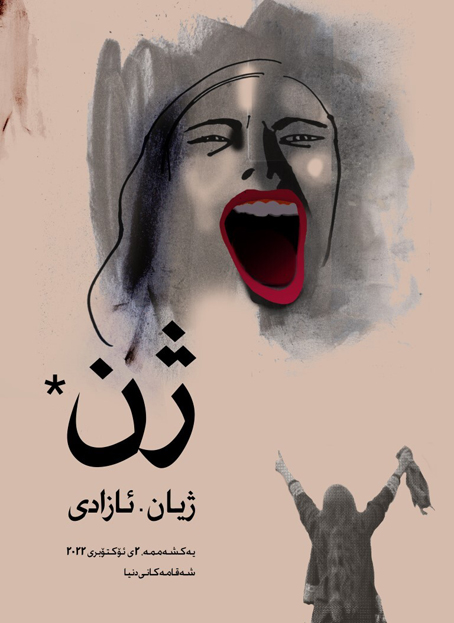|
Here we are to enter THE IRANIAN
WOMEN'S REVOLUTIONISTS against
the supreme leader, the arch-reactionary Ayatollah Ali Khamenei,
and his placeman president, Ebrahim Raisi. The message of
the women when he visited a university is plain: <give way or
get lost> in 2023.
IN MEMORY OF ASRA PANAHI (16)- JINA MAMINI (22) - NIKA SHAKARAMI (16), SARINA ESMAILZADEH (16) HADIS NAJAFI (20), AND MORE WOMEN WHO WERE ASSASINATED SO
FAR BY THE IRANIAN AXIS OF EVIL.
Click here for a total list so far
Dear reader, from here on the 'Woman,
Life, Freedom' pages menu will look a bit different and this
to avoid too many pop-ups ,meaning the underlined period
in yellow tells you in what period you are and click on another
underlinded period to go there. However, when needed a certain
topic will be in yellow meaning it's a link to go that topic and
will open in a new window. If you dissagree about any change feel more than free to let me know what you
think at
info@cryfreedom.net
(Updates
September 13, 2024)
|
December 31,
2023 - Preface about the below 3 heroines of Iran by
Gino d'Artali : Beacons of hope and inspiration on the
road towards a long and free Iran . * Jina Amini,
our sister/daughter who martyred herself for freedom;
*Narges Mohammadi, our sister and as I call her 'mother
of a free Iran' and winner of the Nobel Prize of Freedom
2023 and sentenced five times to a total of 31 years in
prison and 154 lashes but who refuses to give in to the
mullahs' regime to wear a hijab or bow to their demands
and therefore is refused medical care although needing
it badly and bringing her live in danger but says "Victory
is not easy, but it is certain" * and Maryam
Akbari Monfared, our sister who's encarcerated since
15 years and refuses to bow down to the mullahs saying "Finally,
one day, I will sing the song of victory from the summit
of the mountain, like the sun. Tomorrow belongs to us"
Read all about them here and let them inspire you on
your road towards a long and free Iran or as we say in
the West: 'Three strikes and the mullahs' regime is out'
Be the finalizing strike dear and brave dissent |
|
A to VICTORY tribute to
NARGES MOHAMMADI
Sept. 2, 2024:
"Shameless": Imprisoned Nobel Laureate in Iran Slams
Custodial Death..."
August 9, 2024
"My heart cries...
(For Narges Mohammadi and all suffering but fighting
back mothers/women)
and earlier heroic stories
May 6, 2024
"Tyranny will fall"

"Victory is not easy, but it is certain"
watch it here :
https://www.youtube.com/watch?v=8LAMPz57Aqw
Click here for a news-overview
from January 15, 2024 'till October 31, 2023
|
JINA AMINI'S VOICE IS ALSO HEARD
And do read also the above linked incredible
December 2023 update!
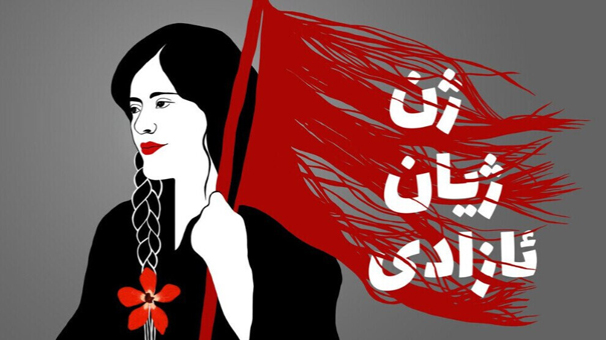
despite the mullahs'
regime to force it down!
Her mother speaks
out loud and clear
September 10 - 6, 2024
Second Anniversary of Jina
Amini's state-sanctioned killing...
a wave of arrests of her fellow-citizen
Click here for earlier news of the
'Woman, Life, Freedom'
revolution
MARJAM AKBARI
MONFARED

June 24, 2024:
The Iranian Regime
Judiciary Launches a New Case to Seize the Assets of Maryam Akbari Monfared and Her Family, in Revenge for
Seeking Justice for Her Siblings Executed in the 1980s
Dec 30, 2023: Not bowing for the mullahs' regime
she says:
"Finally, one
day, I will sing the song of victory from the summit of
the mountain, like the sun. Tomorrow belongs to us"
|
PAKSHAN AZIZI
Actual News:
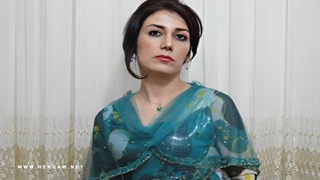
Actual News:
September 10 - 9, 2024
"Twenty-Six Human Rights Organizations Demand Immediate
Cancellation of Pakhshan Azizi's Death Sentence..."
and more actual news
September 5, 2024
"You dictator, I am Arash, fire
responds to fire,"
August 19, 2024
Sentenced to Death for Assisting
Women Targeted by ISIS
And read here her full story:
July 23 - 22, 2024
"Denying the Truth,
and Its Alternative"
September 5, 2024
"You dictator, I am Arash, fire
responds to fire,"
|
|
Please do read
the following articles about heroines who risk live and
limb for the women-led revolution and no matter what
they'll never give in nor up!and other stories: click on the underlined
topics:
September 11, 2024:
Activists in Evin Prison Protest with Hunger
Strikes...
September 11, 2024:
A Quiet Revolution Continues...
September 10, 2024:
Iranians Defy Internet Restriction...
September 10, 2024:
Pedram Azarnooshís Killing continues...
Sept 9, 2024:
Suicide Crisis in Iran...
and
Click here for previous inspiring
stories and articles
incl. Red Alerts |
Read here more about the
Nurses' demands - "A nurse will
die, but will not accept humiliation,":
and updates:

SPECIAL
REPORTS PALESTINE
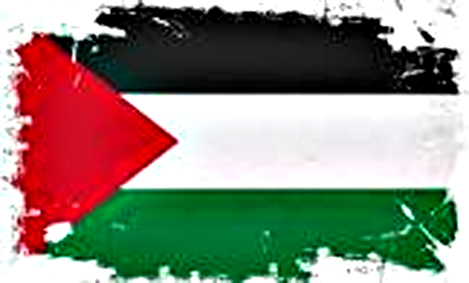
Click here for actual updates
Updated
Sept. 2, 2024 |
'The mullahs' regime / OHCHR* gallows' dance'
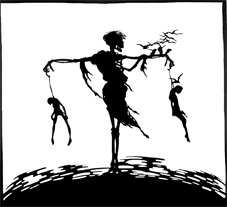
In refeclection and updates of
"NO to executions" uprise:
July 8 - 4, 2024:
The-death-sentence-against-Sharifeh-Mohammadi
June 15, 2024:
Prisoner Swap with Iran is
Shameful Reward
June 5 - May 23, 2024:
It |Iran| puts people to death in
order to terrorize the population into silence.
and other stories
*OHCHR - UN Office of
the High Commissioner for Human Rights
Click here for earlier reports
|
|
|
May 10 - 3, 2024
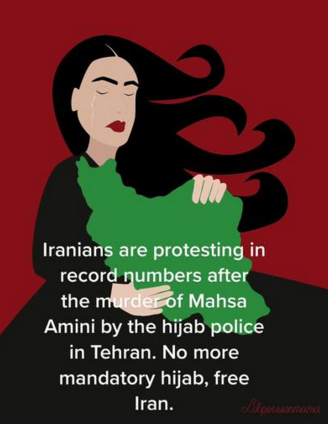
'War against the No-hijabi
women'
|
September 10 - 6, 2024
<<Twenty-Six Human Rights
Organizations Demand Immediate Cancellation of Pakhshan
Azizi's Death Sentence...
and <<Iranian Woman Dies
from Injuries Sustained During 2022 Protests...
and <<Iran Continues
Arrests Ahead of Mahsa Amini's Death Anniversary...
and <<Three Women Prisoners
in Iran Strike Against Treatment in Jail...
and <<Ailing Political
Prisoner's Brother Highlights Medical Neglect in Jail...
and <<Mother Decries Slow
Justice After Morality Police Beat Teen Girl...
and <<Inhumane Conditions
for Female Inmates in Borujerd Prison...
and <<Disabled Kurdish
Political Activist Arrested and Extraditioned...
and <<Yasra Aref, an Afghan
Woman, and Her Infant Face Inhuman Conditions in Iran's
Evin Prison...
and more actual news
and to earlier actual news |
When one hurts or kills a women
one hurts or kills hummanity and is an antrocitie.
Gino d'Artali
and: My mother (1931-1997) always said to me <Mi
figlio, non esistono notizie <vecchie> perche puoi imparare qualcosa da
qualsiasi notizia.> Translated: <My son, there is no such thing as so
called 'old' news because you can learn something from any news.>
Gianna d'Artali.
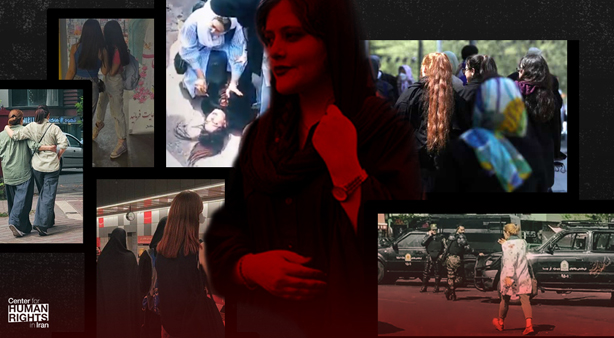
A Quiet Revolution Continues
Center for Human Rights in Iran - Sept 11 2024
<<A Quiet Revolution Continues in Iran Two Years After the Woman Life
Freedom Uprising
Interviews with Iranian Women Show Civil Disobedience Takes Root as
Hijab is Discarded
Rejection of the Symbol of Islamic Republic Repression Becomes
Normalized
September 11, 2024 - Two years ago, 22-year-old Mahsa Jina Amini lost
her life because she was walking down a Tehran street with an <improper>
hijab. She was killed in state custody, only three days after her arrest
for her violation, by Islamic Republic agents. That murder sparked the
Woman Life Freedom uprising that swept across Iran in September 2022, in
which tens of thousands of Iranians-women, men, young, old-took to the
streets for months to express their rage at her death and protest
against the endemic violence and repression of the Islamic Republic. The
uprising was ultimately crushed by a brutal state response that left
over 500 protesters gunned down in the streets by Islamic Republic
security forces, countless protesters maimed and injured, hundreds
intentionally blinded by gunshots, tens of thousands arrested, and an
unknown number of women, men, and children abused and tortured in state
custody. But it did not end there. A quiet revolution has taken place
across Iran, in which women refuse to adhere to what has become the
symbol of Islamic Republic oppression-the mandatory hijab. With their
simple act of peaceful civil disobedience, these women say no-no to the
repression, no to the violence, and no to the systematic discrimination
and gender apartheid that has characterized the plight of women in the
Islamic Republic since its inception. For this, they face violence,
arrest, imprisonment, and torture. Yet they stand firm. More and more
women are on the streets of the cities of Iran without covering their
hair, as this potent symbol of defiance becomes normalized.
The Center for Human Rights in Iran (CHRI) salutes these women and their
bravery, and is humbled by the great price they have paid for standing
firm for their rights and freedoms. To mark this date, we do not want to
speak for them; they can speak for themselves. And so we bring you a
series of excerpts from 12 interviews CHRI has held with women (and one
man) inside Iran over the last few weeks, during August and September of
2024. Their message is overwhelmingly one of determination, resilience,
and hope.
Voices from Iran
"A great revolution and transformation [has] occurred in Iranian women
and girls, and that was learning to fight against our fears."
Mahshid, 32, pharmacist, Isfahan
"We may think the Woman, Life, Freedom movement was suppressed before
achieving a certain outcome, but a great revolution and transformation
occurred in Iranian women and girls, and that was learning to fight
against our fears. After the movement, I removed a thick layer of fear
from myself. I learned to face my fears. The movement taught me that as
a woman, I have a much more important role than what society and the
government have imposed on me. Around me, I see many people who, in the
last two years, have had a positive change in their views on many
issues, especially women's rights. Feminism grew even inside of men. In
order to fight for freedom, it is not necessary for people to get beaten
with batons and engage in confrontation. The fight can be waged in other
ways. The struggle takes shape through everyoneís inner growth and
awareness. If everyone does the same, I believe the struggle of the
Iranian people will be successful. A bright future awaits Iran. Pain and
problems can help society grow."
Maryam, high school student, 16, Khuzestan province
"I was a student in middle school during the protests. When news [of
Mahsa's killing] spread, we were all angry, as if all the pain and
restrictions that had accumulated over the years finally exploded. Every
day, the school staff came to work in fear of the students. We wrote
"Woman, Life, Freedom" slogans on the doors and walls, covered the
washrooms with red paint, and drew protest signs. Nobody covered their
hair in the classroom anymore. We would gather in the yard and sing [Shervin
Hajipour's] 'Baraye' and other protest songs. The school staff would
admonish us and tell us to shut up. They lowered our grades, summoned us
to the office, or ordered parents to come to the school and make pledges
of obedience. But the students werenít afraid. Wherever we could, we
also wrote slogans and posted pictures of Mahsa and others on walls
outside of the school."
"Before the movement, only certain people had the courage to appear in
public without hijab, and the general opinion toward them was bad. But
after what happened to Mahsa, public support for women increased.
People's courage increased and their clothing, as well as their
thoughts, changed. Iran's future is unclear. We will defend our rights
as long as we can, but liberation is not easy."
Mina, 20, chemistry student, Mashad, Khorasan Razavi province
"The Mahsa movement changed people. For me, this change was the sense of
courage that blossomed. This courage has not only shown itself in
choosing our clothing, it's also extended itself to other parts of our
lives as women and girls. Many girls who live in traditional and
religious families, like I did, have now found the courage to make
decisions about their own lives and come out from under the shadow of
coercion and orders. I have this sense of courage not only for myself
but also for saving others. I have hope for the future. Of course, itís
true that the current situation is very bad, but I have a lot of hope in
society and the young generation because I can see that people now are
not indifferent to the situation. Before the Mahsa movement, when I was
17 years old, I was disillusioned. I felt stuck in a restrictive
situation that could not be changed. I had set many limits even for
myself. But these restrictions became much less after the Mahsa
movement. It was as if a heavy covering was removed from everything. If
I stay in Iran in the coming years, I would like to engage in civic and
social activities and help girls who have been raised in closed and
restrictive environments."
Manijeh, 62, clothing designer, Tehran
"When the revolution happened in 1979, I was a teenager growing up in a
religious family. My father was a traditional cleric. I had a lot of
problems with my family's beliefs and lifestyle. I got married when I
was young and emigrated from Iran, returning to the country only after
20 years. In todayís generation, I see things that are similar to my
feelings when I was young: defiance, desire for freedom, and liberation
from obsolete ideas. I have high hopes for this generation. I was with
them in many of the protests in the city. Now, like many of the young
girls today, I go out without wearing a scarf. Several times during the
protests, I freed some of the young girls from the hands of the officers
and didn't let them take them away.
I have great hope for the future of Iran and this generation.
Considering that we are approaching the anniversary of the Woman, Life,
Freedom movement, I am excited to see the people's unity and solidarity,
especially among the new generation. I came back to Iran to help this
generation. I want to spend the rest of my life helping young people
because the future belongs to them."
Sepideh, 36, high school teacher, Mashad, Khorasan Razavi province
"I was working as a teacher in a school during the protests. I became
very close to the children in the last few years, and during the
protests, I used to accompany them. I also joined them in a street rally
to protest the poisoning of children in schools. Consequently, the
Ministry of Education fired me and now Iím unemployed. The regional
education officials told me in a meeting that I was fired because of my
activities during the nationwide protests and that I no longer have the
right to be employed. In that meeting, they asked me why the students
liked me so much. Because I was with them during the protests and
supported them, I answered. I said the reason for my friendship and
closeness with the children was the Mahsa movement, and the officials
were surprised I was so frank. Although I lost my job, I feel proud
because of the way I supported the children. Today, more than ever, I
understand the price for freedom is very high but I'm still hopeful for
the continuation of women's struggle to gain freedom."
Shahrzad, 22, architecture student, Mashad, Khorasan Razavi province
"I was active during the protests. I participated in all the
demonstrations, both on campus and outside the university. On one
occasion, I was on the street in front of the university when
plain-clothed agents attacked us and beat us with a baton, which injured
my hands and feet. But I didn't care and continued to participate in the
protests. I think this road to freedom will take many years. It will not
be quickly achieved. I was disappointed, but one shouldnít lose hope. I
didn't think about emigrating before, but now Iím thinking about it. The
events after Mahsa's killing made me very angry and since then, an inner
rage has always been with me."
Maryam, 22, mathematics student, Tehran
"I was very active during the protests. I was beaten several times both
on campus and on the street. At that time, all the young people had a
lot of excitement, passion, and hope. Now that we are going back to
university, I'm sure many who were active before are afraid and may find
they've been expelled. I can't think about the future at all. I'm
afraid. But one should continue protesting in any way one can. For
example, many of my friends and I don't wear scarves in the street
anymore. Itís a form of protest. Before the Woman, Life, Freedom
protests, we chose our clothes based on the government's dictates in
order to avoid getting arrested. Now I donít think about it anymore, and
I wear the clothes I like. We have to continue imposing our appearance,
taste, and lifestyle on the government and come to the streets without
the hijab until it becomes normalized, until there's no point in making
arrests, until everyone appears in public according to their own taste.
Then, if the police want to arrest someone, they will have to arrest
everyone."
Nastran, 28, accountant, Shiraz, Fars province
"For me, the Woman, Life, Freedom movement brought a lot of
amazementóand anger. The anger made me become aware and woke me up. It
introduced me to my rights as a woman and gave me the courage to fight
for them. I wanted to turn this anger and awareness into protest and
resistance and bring others with me to demand our rights. That's why I
decided to write a song and sing about the movement and declare my
protest. I see a bright future for Iran, especially for Iranian women.
They are determined. In the last couple of years, the whole world has
witnessed their determination and it made me hopeful for the future of
Iran and Iranian women, especially this new generation of 15-16-year-old
girls. We should keep hope alive at any cost. We must not forget how
many innocent young people were killed in the Woman, Life, Freedom
movement. I have been going out without a scarf for a long time. I
believe everyone should keep alive the memory and importance of the
movement. I still make music and sing about those days and in this way,
I try to keep the hope for freedom alive. If we are not indifferent to
what is happening around us and are empathetic, surely much better
things will happen in the future. I am hopeful for the future of Iran."
Alireza, tortured (male) protester, 36, Karaj, Alborz province
"I was active during the Woman Life Freedom protests, and was arrested,
tortured, and held in detention for almost six months. I still have many
physical problems due to the severity of the torture. But apart from the
bitter things that happened to me, I believe this movement has raised
people's awareness. At the same time, the hatred and malice of people
who support the government have increased. But the young people do not
give in to the government's restrictive demands. They have chosen their
own path, with a great desire for liberation and freedom, standing
against every kind of oppression. The new generation doesnít acquiesce.
The view of middle-aged and elderly people towards women has also
changed and more respect is given to their rights and dignity. Fewer
people are mistreating each other because we all have a common enemy. We
have won over oppression. It's true that the government is still
suppressing the people, but public awareness is increasing day-by-day.
The support of Iranians abroad is important. The intimidating
atmosphere, the increase in executions, and the lack of support for the
Iranian movement from some western countries, have dampened the
revolutionary aspirations of some. Itís important to get support from
the international community. Defenseless people need that support."
Behnaz, bookseller, 35, Tehran
"I was an active participant in the Woman Life Freedom protests. In the
past two years, there has been a real change in societyís attitude
toward people's bodies and appearances. People have turned away from the
Islamic dress code: you no longer feel comfortable wearing a scarf or
head dress; it feels rather strange. There are prolonged periods of
depression and collective stagnation, then there are sudden hopes for
change. There's a desire to engage in underground and radical activity,
but at the same time, the ability to formulate practical actions is
lacking. There are more efforts to expose the links between various
types of oppression as well as partial attempts at networking. Iím
hopeful for womenís struggles, but also scared of the impact that
reactionary and hostile forces can have on liberal feminists."
Nazanin, activist, 35, Tehran
"In those first days when Mahsa was in the hospital, I didn't even
imagine that such an anti-women society would be ready to come to the
streets and protest. No one realized the golden moment when the movement
began to take shape until people poured into the streets. After the
protests started, I drafted a call to encourage people to come to the
streets against Mahsaís killing and the oppression of women. I didn't
have much hope for its success. An hour before the announced time, when
I arrived and passed Hijab Street, which we now call Mahsa Street, I was
stunned. I couldnít believe so many women had gathered, spinning their
headscarves in the air and chanting. In the following days, I was very
excited, but what I remember is my fear. The level of violence by the
regime's agents was like never before. Being on the street meant the
possibility of being killed, and we all knew it. We usually got
scattered from our friends and lost each other because of the attacks by
agents. We always made a pact to make contact at a certain time every
night to say we had returned home safely. The fear was not limited to
the street; there was also the possibility of being arrested at home. I
was more afraid at rallies in my own neighborhood. On the days when
protesting high school girls came near my house and blocked the street,
I only went out to try to protect them. In some cases, it was as if
teenagers in the rallies were the ones protecting us older people. I
remember once a teenager came and told me to put on a mask [to hide my
identity] and be careful. Two years later, some things have changed, and
some are still the same. I've seen many women who have made a revolution
in their personal lives and broken many barriers and stood firm in
oppressive situations. But Iím not so optimistic about men. Society is
still deeply anti-women. Yet, since the Mahsa movement, if you donít
wear a headscarf on the street, no man will stare at you anymore. Even
though the movement caused a deep shock in society, there is still a
long way to go to change anti-women structures-a path that requires
constant effort. Hopefully, the accumulation of all the things that have
been going on in these years will have an irreversible effect in the
not-so-distant future."
Mobina, university student, 21, Tehran
"The most important change that happened in these two years is in
peopleís mentality. Before the movement, women used to wear the hijab
without thinking when going out of the house. Now, they question whether
to wear the hijab or not. Another change is that now we cannot go to
many places because there are morality patrols, confronting women
without veils. It has affected our security. On the other hand,
solidarity between women has increased, a kind of solidarity that was
rarely seen before; we inform each other about the presence of morality
police. I really have no idea about Iran's future. If something happens
in Iran, it will be at the hands of the young people of our generation.
The fact is that our generation may not have much revolutionary vigor,
but it has spirit and courage, and if these two - revolutionary vigor
and courage - are combined, it would be very good. I think changes in
Iran take time and maybe the generation after us will do something
fundamental." >>
Source:
https://iranhumanrights.org/2024/09/a-quiet-revolution-continues-in-iran-two-years-after-the-woman-life-freedom-uprising/
Women's Liberation Front 2019/cryfreedom.net 2024
|



